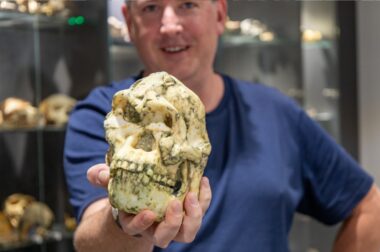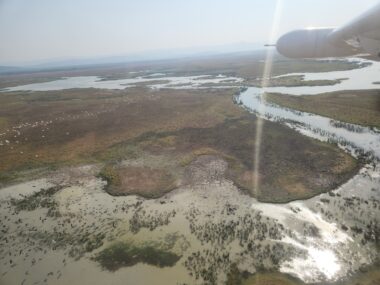Researchers use large-scale data from citizen scientists to analyse the calls of nearly 700 frogs and discover new insights about frog communication.
We all know the familiar “ribbit” of a frog call, but did you know that individual frogs have distinct accents?
Researchers at UNSW Sydney and the Australian Museum have used data collected by citizen scientists to analyse the calls of nearly 700 frogs. The data, provided as part of the FrogID project, has been used to counter a common theory about animal calls.
Grace Gillard, who completed the project as part of her honours at UNSW, and Dr Jodi Rowley, a herpetologist from UNSW’s Centre for Ecosystem Science and the Australian Museum, found that variation in frog calls was not strongly linked to habitat structure.
“We were surprised by the results, because the link between habitat and variation in animal calls has quite a strong theoretical background,” says Ms Gillard, lead author of the study.
These latest findings, published in the Journal of Zoology, suggest that the evolution of banjo frog advertisement calls has instead been influenced by the interplay between a multitude of factors, such as noise from other animals, or anthropogenic noise, including wind and water.
“Importantly, we have shown that citizen science data provides a novel opportunity to examine important ecological theories across a huge spatial scale. And that the venue - a dense forest or an open plain - doesn’t matter for a banjo frog gig!”
The acoustic adaptation hypothesis
Animal communication is vital to the success of the individual animal and in many cases, their entire survival and fitness relies on communication.
“Frog calls are really important, because it's actually one of the most accurate ways of identifying frogs, as frogs all have unique calls,” says Ms Gillard. What’s more, unlike other animals, who might also use visual cues, frogs depend almost entirely on acoustic communication with each other.
Within species, there is often a difference in the advertisement call of individuals. “Think of it like an accent,” says Ms Gillard. “But while we’re aware of the variation, we don’t really know why they can vary so much.”
One theory is the acoustic adaptation hypothesis, which suggests that animals communicating acoustically adapt their vocalisations to the local conditions to optimise transmission through their habitat.
This is because the surrounding environment plays an important role in the transmission of acoustic signals by distorting and reflecting sound waves, causing echoing, and decreasing the distance the call can be heard from. The effect of the surrounding habitat can influence calls so much that they might not reach their intended audience – for example, a male calling out for a mate may not be heard by nearby females.
Habitat effects can be counteracted by subtle changes in the pitch, duration, and rate at which an animal calls. Because of this, the physical environment is thought to be at least partially responsible for the evolution of variation in advertisement calls.
Ms Gillard and Dr Rowley set out to test this theory for banjo frogs – a group of four closely related species. As banjo frogs are widely distributed throughout Australia, and are found in a wide range of habitats, they are ideal study species to test the acoustic adaptation hypothesis.
Analysing the calls of nearly 700 frogs
“We saw there was a gap in frog research for this hypothesis,” says Ms Gillard. “A lot of previous research with frogs was using really small-scale studies – often fewer than 100 individual frogs. So you can't really capture the full geographic diversity in frog call if you're not actually sampling that many frogs.”
This where citizen science data comes in. The FrogID project is an app developed by the Australian Museum, where citizen scientists can record the calls of frogs from around the country. “We had thousands of recordings of banjo frog calls at our fingertips. Using this data, we analysed nearly 700 banjo frog calls from across their entire range, covering an area of over 1.7 million km2, from Tasmania to Far North Queensland, and everywhere in between.”
The research duo then paired the data from FrogID with remote sensing imagery to get a measure of canopy cover. “We looked to see whether there was any correlation between the level of canopy cover and the acoustic parameters of each frog call.”
Using a sound visualisation system, Ms Gillard was able to analyse dominant frequency (the peak frequency of the call), the duration of the call and the rate at which a frog calls.
The importance of citizen science
Analysis found that while banjo frog advertisement calls are highly variable in terms of their pitch, duration, and call rate, they are not strongly related to habitat structure, as measured by tree canopy cover. “Our findings have suggested that other factors may have a greater influence over the variation of Banjo frog calls. It's likely going to be a combination of all different factors like more fine-scale features of the environment, acoustic competition from other frogs, and noise interference from wind, water, and other animals,” says Ms Gillard.
Ms Gillard highlights that citizen science allows researchers to analyse large amounts of data from all over the country.
“These frogs are found in Western Australia, Tasmania and all along the east coast up to Far North Queensland. And so if I were to go and try to analyse 700 calls in the field, well it would take at least 700 nights of recording calls, but also the time taken to travel between sites, and find the calling frogs, which is just not feasible.
“Next for this area of research, would be looking at different species of frogs,” says Ms Gillard. “If we could do this research with different frog species with more complex calls, it might reveal more of a signal for habitat.”
Contact details:
Lilly Matson, [email protected],
0426 656 007
Claire Vince, [email protected], 0468 726 91


